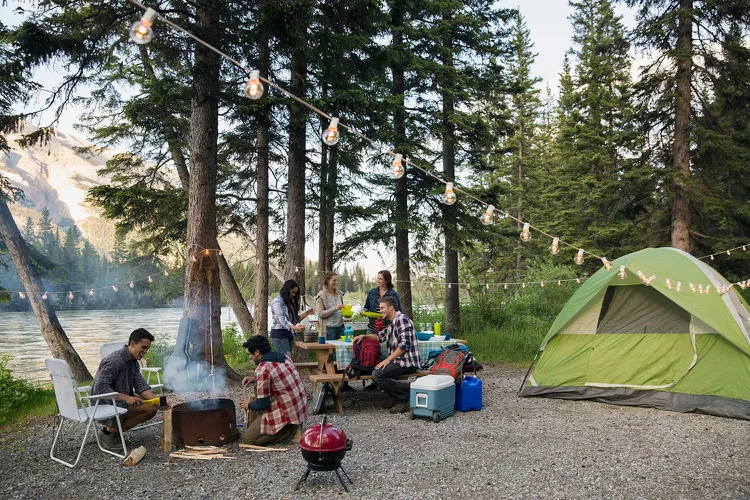Camping Guide Summary
Public Campgrounds
Public campgrounds will fall into two basic categories: public or private. Public campgrounds are usually managed by government agencies and include those found in national and state parks and forests, Bureau of Land Management areas, and Army Corps of Engineers projects. On the other hand, private campgrounds are typically RV parks and campsite resorts owned by private citizens or businesses.
Public campgrounds offer the largest choice of campground destinations, typically funded by tax dollars. These campgrounds are often found in scenic areas or lands intended to preserve the natural environment for outdoor recreation. Moreover, the quality of service and amenities is consistent nationwide.
Campground Resources
While no single website contains all the information about every campground in the U.S., several websites serve as definitive sources for details about different types of campgrounds:
- National Parks: The National Park Service offers extensive information about national parks, including visiting guidelines, history, and logistics such as how to obtain a park entrance pass.
- USDA Forest Service and Army Corps of Engineers: Reserve America is a site dedicated to trip planning, providing campground information, hunting and fishing licenses, camping guides, and more, helping travelers find camping locations in various cities.
- Bureau of Land Management: The U.S. Department of the Interior provides a directory of BLM-managed public lands, offering over 245 million acres for outdoor adventures across more than 12 states.
- State Parks: A list of state parks can be found on the Tourist Information Directory, which includes information and links to dedicated websites for each location.
National Parks (NPS)
The national park system comprises hundreds of parks, recreation areas, and facilities, with over 100 campgrounds open to the public. These campgrounds typically operate on a first-come, first-served basis, while some may offer online reservations.
Fortunately, national park campgrounds are affordable, with nightly rates generally ranging between $10-20 and a maximum stay of 14 days. Facilities usually include clean restrooms, hot showers, and, in some cases, laundry services. Campsites also feature picnic tables and fire rings. Since national parks attract many visitors, particularly during holidays and summer months, early planning is advisable.
National Forests (USFS)
Campers can choose from thousands of campsites located at over 1,700 national forest locations managed by the USDA Forest Service, Army Corps of Engineers, National Park Service, and other agencies. Detailed information about individual campgrounds is accessible via Reserve USA and the National Recreation Reservation Service (NRRS).
Locating a campground on Reserve USA is straightforward. Users can select a U.S. map or view a list of states, leading to a localized map displaying nearby campgrounds. Each campground page provides information about the area and a detailed layout, allowing travelers to find suitable campsites that fit their needs, including information about special events, services, and amenities.
Army Corps of Engineers (ACE)
The Army Corps of Engineers is well-known for its involvement in dam construction, controlling river flows, building lake reservoirs, and generating hydroelectric power. Additionally, they provide access to riverside and lakeside areas for recreational activities such as fishing, boating, and camping.
With over 4,300 recreational areas at more than 450 lakes under ACE management, options abound. Searching for campgrounds is simplified by ReserveUSA. ACE facilities feature clean, well-maintained campgrounds with basic amenities, including showers, restrooms, water, picnic tables, and fire rings. Access to services for boaters and fishermen, such as marinas and tackle shops, enhances the recreational experience.
Bureau of Land Management (BLM)
The Bureau of Land Management manages millions of acres of U.S. land, encompassing over one-eighth of the country’s landmass, and provides ample outdoor recreation opportunities.
BLM areas include 34 national wild and scenic rivers, 136 national wilderness areas, nine national historic trails, 43 national landmarks, and 23 national recreation trails. Campers can enjoy these natural wonders from approximately 17,000 campsites at over 400 campgrounds, primarily located in western states.
Although most BLM campgrounds are primitive, they typically require no long hikes to access. Sites usually feature a picnic table and a fire ring but may lack restrooms or potable water sources, so travelers should plan accordingly and bring their own supplies.
BLM campgrounds are generally small and available on a first-come, first-served basis. Rather than having a campground attendant, visitors may find an iron ranger for deposit collection, with fees usually ranging from $5-$10 per night; however, many campgrounds do not charge any fees.
For finding BLM campgrounds, Recreation.gov is an easy-to-use resource. It allows users to search for outdoor activities on public lands, including national parks, national forests, and Army Corps of Engineers projects, displaying campground details and area descriptions.
State Parks and Forests
The state park systems provide excellent opportunities for outdoor enthusiasts to appreciate nature. Typically, a state park is within a reasonable distance from where you live. While state parks are popular camping destinations during weekdays, their popularity skyrockets on weekends throughout the year.
To plan a camping trip at a state park, begin by selecting a specific state. The Find Your Park application allows for searches by park name, location, or activity, providing excellent descriptions and photos for each option.
State parks boast outstanding facilities for family camping. They are well-maintained and offer numerous amenities to enhance your stay, such as clean restrooms, hot showers, convenience stores, marinas, and more. Campsite fees vary but are seldom higher than $15-$20 per night, and many campgrounds provide RV sites with electrical hookups, water, and/or dump stations.
Campground Tips
- Read Reviews: Gather recommendations from family and friends about excellent camping locations in your area, or peruse campground reviews for ideas.
- Make Reservations in Advance: For summertime travel, make reservations as early as possible. Popular campgrounds tend to book quickly during weekends and holidays. Be sure to understand the cancellation policy before confirming any reservations.
- Deposit Fees Correctly: For public campgrounds with an iron ranger, ensure you place your nightly fees in an envelope with your name and site number before depositing in the collection box.





